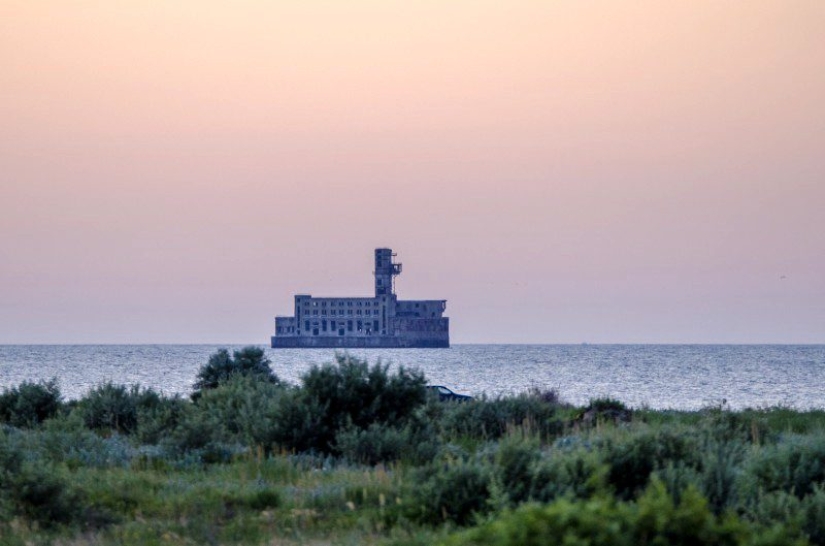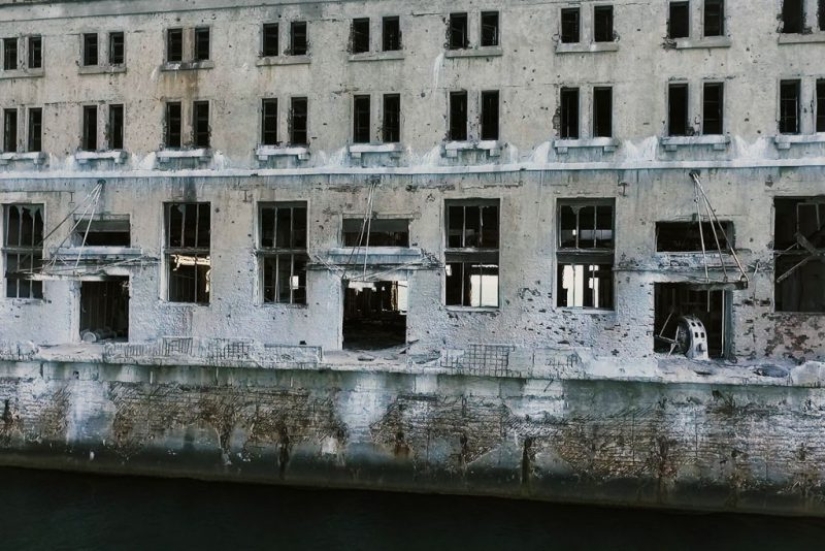Caspian Fort Boyar - the place where Victory was forged, and now the wind blows
Categories: Design and Architecture | History | World
By Pictolic https://pictolic.com/article/caspian-fort-boyar-the-place-where-victory-was-forged-and-now-the-wind-blows.htmlIn the open sea, just 2.5 km from the city of Kaspiysk, there is an abandoned bastion that locals call the "Dagestani Fort Boyar". But this unusual structure, despite its menacing appearance and unusual location, has nothing to do with coastal defense. Its builders pursued more global goals - strengthening the defense capability of an entire country on its maritime borders.

The fortress of stone and concrete is the secret eighth workshop of the famous Dagdizel plant, where some of the best torpedoes in the world were created for decades. Built 80 years ago, the workshop was used as a sighting station, where the formidable weapon of the Soviet fleet – steam-gas torpedoes – were tested.
Deputy Director for Technical Issues at the Dagdizel Plant Mikhail Khalimbekov once told the capital's journalists the story of this building. An engineer who worked at Dagdizel for over 50 years, he is one of the few old-timers at the plant who knows the history of the "Dagestani Fort Boyar" firsthand.

But it was incredibly difficult to erect such a large building in the open sea, known for its capricious nature. Therefore, the sighting station began to be built on the shore, in a pit dug specially for this purpose. On land, a powerful foundation structure was made of reinforced concrete, which was then towed out to sea.

To install the foundation, a 6-meter-high rock cushion was poured onto the bottom, and a concrete base, also 6 meters high, was placed on it using floating cranes. The sea depth at the construction site was such that all 12 meters of the base disappeared into the waves, leaving only a platform on the surface. It was on this platform that they began building the eighth workshop, which was commissioned in 1937.
The unique workshop had a total area of over 5,000 square meters, and its tower rose 42 meters above the sea surface. The underwater walls of the building were 1.5 meters thick, and the glass in the windows was 7 mm. Such power was needed to fight the storms for which this region of the Caspian Sea is famous.

The workshop had an elevator for moving between floors, a canteen, a dormitory, a library and even a cinema. The station's living and utility rooms were designed for 60 people, who were provided with absolutely everything necessary for work, rest and solving household needs. Electricity was supplied to the workshop via a cable laid along the seabed. The station also had its own diesel generator units in case of unforeseen situations.
It would seem that 2.5 km from the shore is not much at all and there was no need to create a whole infrastructure on the water. But only those who are not familiar with the capricious climate of the Western Caspian can reason like that. Storms in winter here last for 1.5-2 months and communication with the shore at this time was practically absent.

Contrary to the rumors that still circulate in Kaspiysk, no secret torpedoes were produced in the marine workshop of the Dagdizel plant. The deadly naval weapons were produced on the shore and then delivered to the marine fort for testing. The military experts, who made up the bulk of the workshop's workforce, were interested in the torpedoes' performance, that is, their speed and trajectory.
The torpedo was launched into the sea and its "behavior" was monitored. Of course, the products were not equipped with explosives, which were temporarily replaced by ballast during testing. After the torpedo had completed its voyage, it was found and transported back to the workshop. Here it underwent a "dry overhaul" - disassembly, drying, filling with a charge and sending to the warehouse. From there, the torpedo was taken into combat service.

The sighting station system worked like clockwork and an emergency occurred only once - in 1954. Then one of the torpedoes unexpectedly changed its trajectory and flew onto the beach of Kaspiysk. Fortunately, no one was hurt that time, and the workshop specialists began to work more carefully.
During the Great Patriotic War, the Dagdizel plant worked in three shifts. Testing of finished torpedoes at the sighting station did not stop. The plant's capacity was designed to produce 1.5 thousand torpedoes per year, and that is how many the plant produced until 1941. In 1942, the plant's specialists were able to give the country 3 thousand units of production. During the war, the plant produced 54% of all torpedoes in service with the Soviet Navy.

In 1943, when the war came close to the North Caucasus, the entire Dagdizel, together with its equipment, workers and engineers, was evacuated to Alma-Ata. Incidentally, the plant remained in Kazakhstan, where it manufactured military and civilian products until the collapse of the Soviet Union.
Another military plant was moved to the vacated workshops in Kaspiysk, but it produced aircraft torpedoes that were more needed by the nearby front. The Germans passionately wanted to capture the unique plant, so despite the existing opportunity, they did not bomb either the plant on the shore or the station at sea. Bombers thickly strewed the sea near Kaspiysk with bombs and mines, fearing that the unique equipment would be taken out of the plant by sea, but the Nazis were unable to reach Dagestan and seize the enterprise.

The decline and subsequent closure of the targeting station were linked to technical progress in the military industry. The new torpedoes adopted by the fleet were designed for use at depths of 200 to 500 meters, while the "Dagestani Fort Boyar" could offer a maximum depth of 13 meters.
The option of building a sighting station opposite Derbent, where the depth allowed, was considered, but then it was decided to move the testing ground to the Black Sea. As a result, the eighth workshop of the Dagdizel plant turned out to be of no use to anyone and it was closed in 1966. For another 10 years after that, the station was under guard, and then the remaining equipment of the workshop was taken away, and the archive was destroyed.

The workshop is still on the plant's balance sheet, but it is unlikely to be needed by anyone. After the rise of the Caspian Sea, which occurred from 1978 to 1995, waves and ice floes destroyed its foundation. The testers of military ekranoplans also contributed to the chaos reigning in the fort, aiming the guns of their fantastic ships at a lonely building in the open sea.
Before the shelling, water did not penetrate inside the station, since all the torpedo test ports were reliably protected by shields made of larch logs. The ekranoplan shells destroyed these barriers and now, during storms, the waves freely wash over the workshop premises.

In addition, one of the shells damaged the tower's supporting structures, causing it to tilt, and another hit the premises containing the remains of illiquid equipment and caused a fire. The fire raged inside the island building for several days and destroyed everything that the factory workers and enterprising locals had not managed to take away.
During the perestroika years, a Dagestani entrepreneur proposed giving the sighting station a new life by opening an entertainment complex with a hotel and casino there. But the KGB, living out its last months, did not approve the project, since there is a large parking lot for border warships in sight of the complex.

The option of demolishing the abandoned workshop was also considered, but it was not approved by local authorities. To destroy a structure built in good faith, a charge of enormous power is needed. In such an explosion, the shock wave could damage both Kaspiysk and several small fishing villages in its vicinity.
Thus, the "Dagestani Fort Boyar" lives out its days, attracting tourists with legends invented by locals and gradually falling into ruin. Meanwhile, when it disappears, we will lose an important monument of the war years, which reminds us of the people who forged the Victory in the rear.
Recent articles

At first glance, these colorful works look like ordinary paintings - but upon closer inspection, it turns out that they are made... ...

I want to somehow distract myself from the news about the pandemic and plunge into the beautiful. Here, for example, is a story ...

Serbian surrealist artist Dragan Ilić creates astonishing and provocative paintings that blend symbolism with eroticism, and ...